Trend #5 of my ‘23 Trends for 2023” – Transformation, Not Innovation!
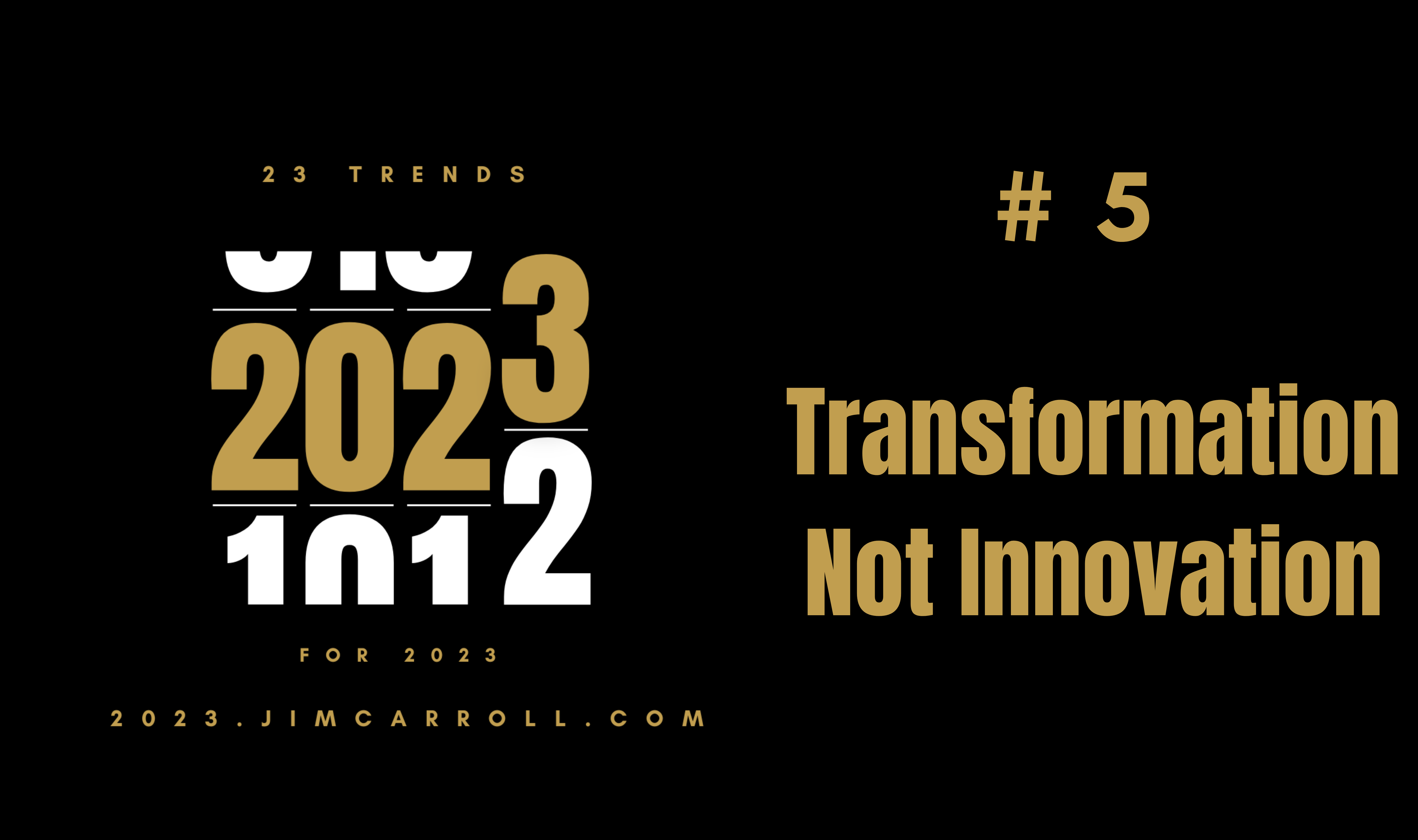
And my advice is simple:
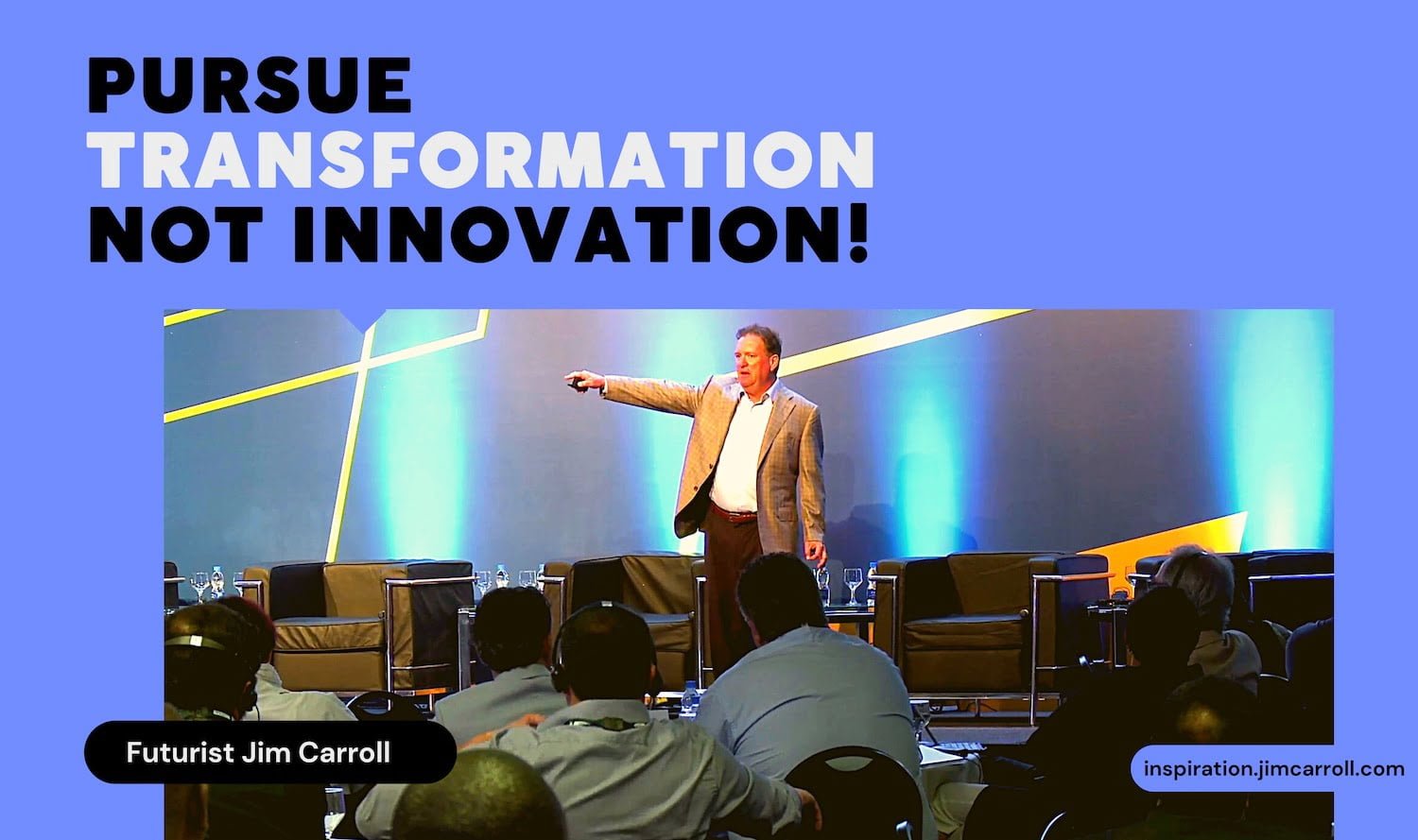
What Is It?
We are living in a period of time that is seeing massive transformation occurring within every single industry. Entire industries are being turned upside down, the fundamentals are changing, and in 10 years, they won’t look anything like they do today.
For you, the future will see fundamental transformation in:
- the products you develop
- the services you deliver
- the methodologies you use
- the materials at the heart of it
- the skills that are required
- the speed with which you operate
- the speed at which you are impacted
- the competitors that you face
- the revenue that you generate
- the age group of those you were up against the collaboration you require
Transformation is far more difficult than nibbling around the edges of change, and it’s been a focus of many of my talks over the years.
What’s driving it? BIG industry change. Watch these two videos where I take the audience on a voyage looking back from the future – the year 2030 – to our world today, to understand how things have changed. I’ve summarized these trends here,
What is transformation? It’s aligning with the fact that just about everything around you is set to change. I document that on this page: “20 Trends into 2030: Are You Ready for the Massive Transformation of Just About Everything?” It’s actually the most heavily trafficked page on my site, bar none!

When you examine the trends into 2030 as outlined on that page, you come to realize the essence of virtually every single industry is set to change. You can no longer just innovate your way into the future – you need full and complete transformation.
I’ve always described innovation on stage by suggesting that it is an organization that is challenging itself continuously with three key questions; how can we run the business better? How can we grow the business? And more important, how can we transform the business? Question 3 has now taken on a new sense of urgency and importance, and so that is my trend #5 of ’23 Trends for 2023!’
The Speed of Transformation
Transformation is real, it’s big, and it’s happening faster than you think.
Do you think your business model, your products, your organization, your culture, your legacy … will survive tomorrow? It won’t unless you challenge yourself to transform!
Leadership and Transformation
The trend is directly related to something I’ve noticed in the last few years but really became noticeable in 2023 – and that is it’s now the CEO who realizes that the future is accelerating and that everything, going forward, will be fundamentally different. That transformation is necessary to deal with it. BIG transformation.
Shouldn’t that always have been the case? Not really, as I describe in trend #2: Inevitable Inevitability! For a long time, many senior executives have been in denial about the changes occurring in their industry. That is no longer the case, and to adapt to it, fundamental transformation is required.
I’m noticing this trend directly within my own business – in that the folks who are requesting insight on aligning to the future aren’t just mid-level staff anymore – it’s the CEO. And the topic isn’t just how to achieve an innovation mindset within the organization – it’s how to undertake a complete transformation of the organization. It’s no longer ‘how can we innovate to keep up with the future?‘ It’s ‘how do we completely change who we are, what we do, and what we pursue to align to a future that will be fundamentally different?‘
That’s why I’ve put together a topic page specifically aligned with the thinking of this crowd – go where the clients are!
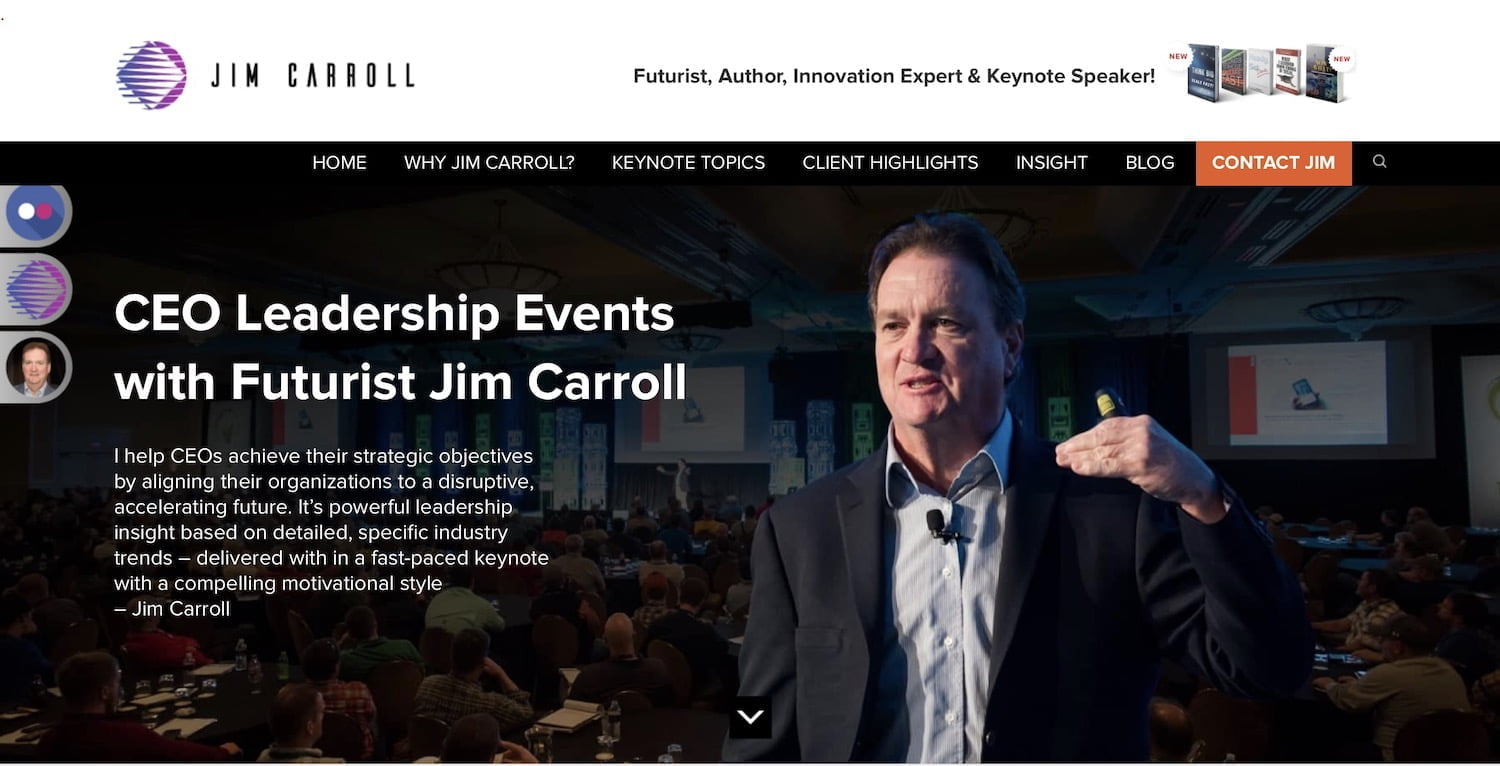
The idea of complete transformation at the organizational level was hammed home to me in late August 2022 when the CEOs of two global companies were busy trying to book me for events they were holding for their leadership team around the same date. Due to logistics, I couldn’t take on both, but after having long exploratory calls with both of them, I realized they were of a similar mindset: they needed to go big with their alignment to obvious disruptive future trends (transformation) rather than just nibbling around the edges with continuous small steps (innovation.)
it’s pretty clear that in their mindset, they know what needs to happen in terms of organizational transformation. Everything needs to change: the markets they are operating in are undergoing a fundamental change and so too must their product or service. To get there, they must shake up how they operate, and this involves everything from the skills they have and how they organize access to them; the collaboration that currently exists with the organization and what it needs to go forward; the strategies being pursued vs. the strategies in place. EVERYTHING needs to change, and that’s transformation.
And so you need to come to a decision – you either go BIG or don’t bother at all.
The outcome should be obvious!
Case Study: Black & Veach – CEO Transformation Leadership Meeting, Kansas City
Disrupt before you are disrupted! The future requires transformation, not just innovation!
The CEO of this massive global infrastructure company thought that Jim Carroll would be the perfect expert to highlight the journey the organization must make to align to a new and different future. Operating in the global infrastructure industry with a focus on energy, water, telecom, roads and bridges, and more, the CEO knows that the future of infrastructure is smart, connected, aware, intelligent, and will be built using new methodologies, advanced materials, and with increasing innovation.
He brought me into help deliver his message at a meeting of his global team of 300 senior executives in Kansas City, the first in-person get-together post-Covid.
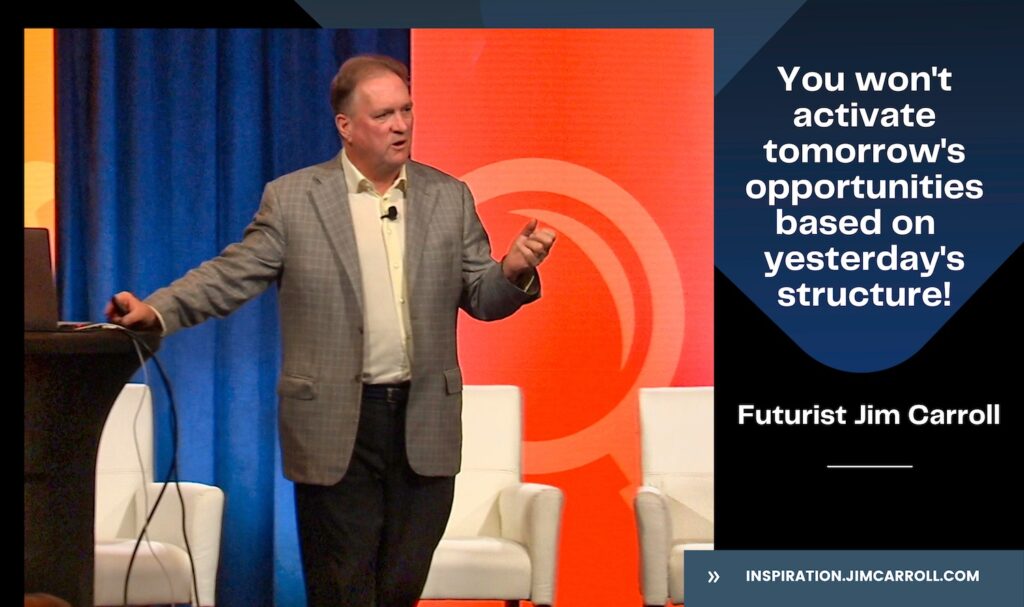
One of the key points I made? “Change is hard. Transformation is even harder!”
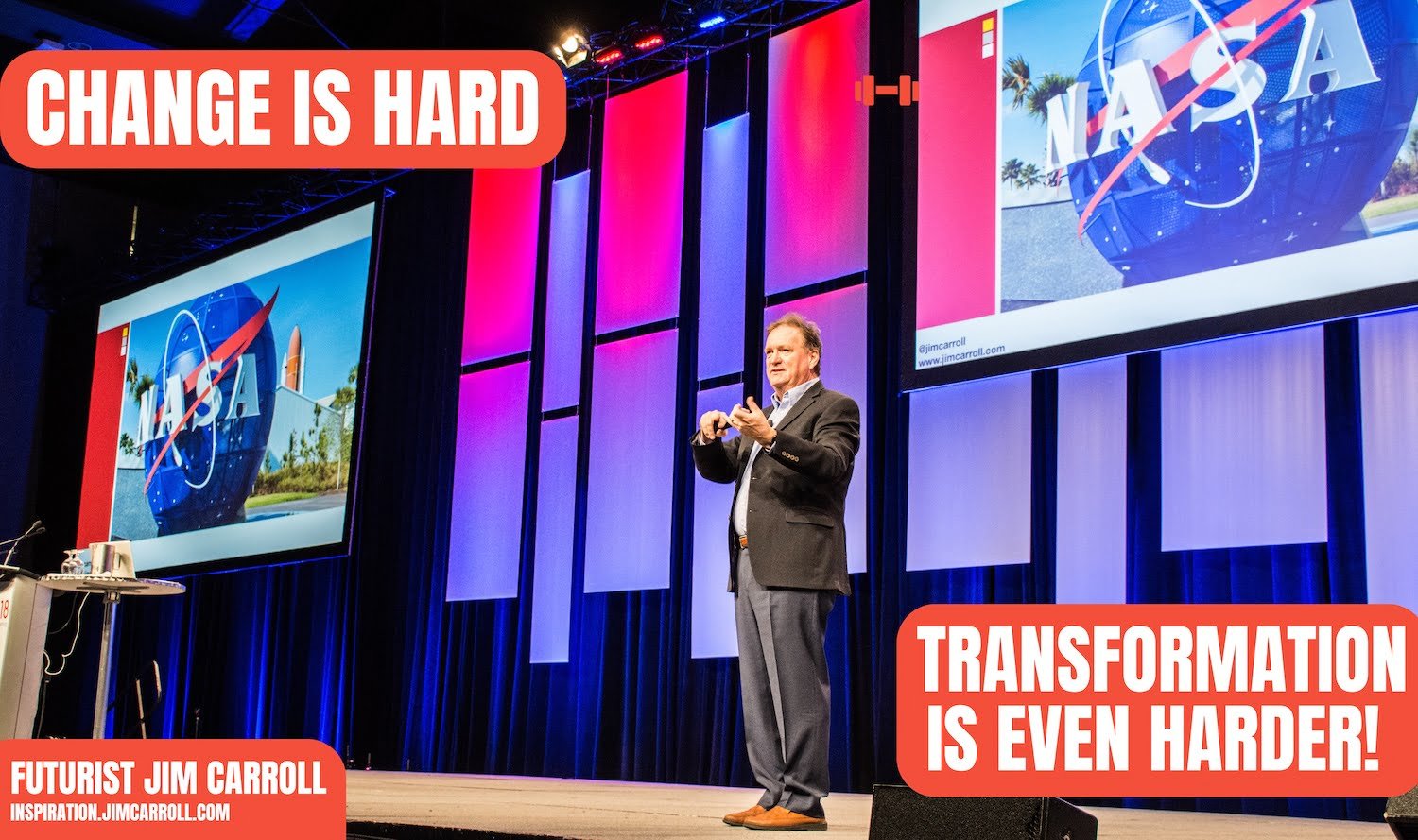
The word ‘transformation‘ has been used a lot in our discussions as he recognizes that the massive disruption underway in his industry means that everything is changing pretty rapidly, and the company must change at the same speed. The changes can’t be small – a fundamental and complete transformation is required. He recognizes that everything the company does and how it does is changing forever and that if they don’t step up to the realities of this, they will fall behind.
Case Study: Kalmar Ottawa
“Don’t just think innovation: think transformation!”
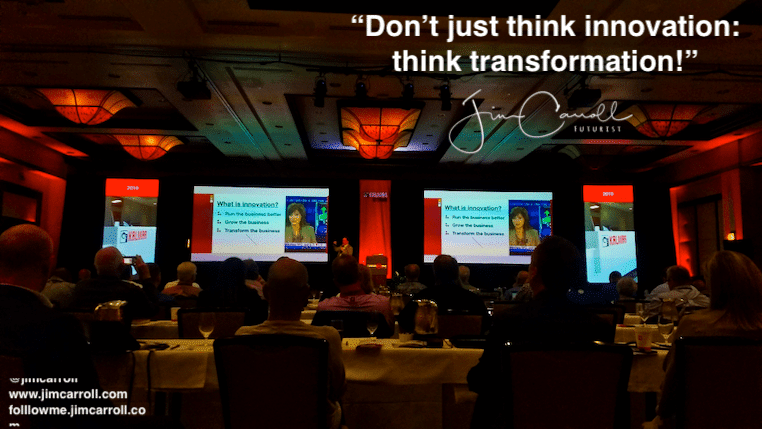
What if your world changes – you used to sell highly specialized trucks based on gas and diesel, but might one day be selling highly intelligent, autonomous self-driving, self-diagnosing connected vehicles that run on electric batteries? And you are no longer selling just a truck, but a self-diagnosing service level uptime guarantee?
That’s what happens in a world in which we head into the future. Over the years, I’ve done many dealer meetings – Volvo, Mac Trucks, and others. I do a lot of talks for transpiration companies struggling to align to the era of acceleration – Mercedes Benz, Chrysler, and others. The transportation sector is seeing themes massive change since the invention of the Model T!
And so while there is a lot of talk of the need for innovation, the proper strategy involves much more than that – transformation. Sometimes tinkering with new ways of doing things is not enough – you need to do entirely new and different things. ‘Transformation’ is a great motivational word, because it implies and involves complete and fundamental change. “Transformative change.” And it’s often necessary to deal with the era of acceleration.
That was the focus for which the CEO of this organization brought me in – to talk about big transformation.
Case Study: NASA
Even NASA had to struggle with the deep transformation that must come with the future and invited me a number of years ago to address the issue with a leadership team. Consider the context at the time – commercialization of the space industry was picking up, ending a world that previously only saw national agencies in the industry.
Some folks in the organization were still struggling with this issue – some viewed a future with new partners like SpaceX to be a threat – others saw it as an opportunity. But clearly, the world was going to involve a different future- and a complete and fundamental transformation was necessary, not just simply change. My job was to set the stage for the reality of the future, to help them align with reality. You can read the summary post of my dinner talk here.
Case Study: NASA (again!)
I was also brought into NASA’s Goddard Space Flight Center, outside of Washington, where I was to deliver a keynote for a senior leadership team.
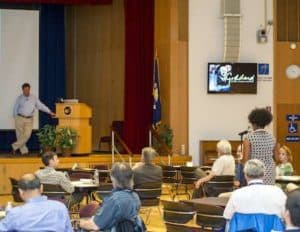
The theme of my talk? In the grand scheme of things, over the long term, “the business of space is changing,” and organizations such as NASA need to evolve with the new business models that are emerging.
Of course, they know that; but the challenge is working the message through the organization, encouraging people to think differently about the future. That was my job in speaking to several hundred of their top research scientists, innovation partnership directors, and others.
This was my second keynote for NASA: a few years earlier I spoke outside of Houston to a group of astronauts, launch directors, mission controllers and other folks with fascinating careers!
Consider the reality faced by any science-driven, government-funded organization such as NASA today, particularly with the ongoing debate over the size and scope of government spending. It’s a reality that involves:
- funding and budget cuts on an ongoing basis
- cancellation and gutting of programs
- greater pressure on remaining initiatives
- a growing public weariness with all levels of government, with resultant policy debate on the purpose and benefit of programs such as those carried out at Goddard
Contrast that to the rapid emergence of what some call the “NewSpace” industry, as a series of bold thinkers, iconic entrepreneurs, crowdfunded teams and others look to opportunities in the heavens as the “next big thing.”
- it’s estimated that today, there are 350 companies worldwide in the “NewSpace” industry
- 75% are privately held
- opportunities being examined not just space tourism, but in-space manufacturing, pharmaceutical development, and asteroid mining
- investors include such folks as Eric Schmidt (ex of Sun Microsystems), Charles Simonyi (ex of Microsoft), James Cameron (Titanic and Avatar), and Larry Page (of Google), among others
There is a quote from Bill Gates that I use in every presentation I do: “Most people tend to overestimate the rate of change that will occur on a two-year basis, and underestimate the rate of change that will occur in ten years. Don’t let yourself be lulled into inaction.”
So it is with NASA and similar industries — the industry you are in today will look nothing in 10 years like it does today.
My message: Transformative change is happening, and it is happening quickly. The key for research-based science centers such as Goddard is that they must reach outside of their world in terms of innovation and opportunity; collaborate and partner in new and different ways; respect the acceleration of science that is emerging on crowdfunding networks.
Digging Deeper into Transformation
This reality is common to so many organizations today. How big is the change that our future involves? Start with this post: 20 Trends into 2030: Are You Ready for the Massive Transformation of Just About Everything?
It’s reproduced here. Think about how each and every industry around you is going to change. All of these predictions are based on real, actionable trends which are happening right now.
Transportation: We’ve gone from driving cars and trucks based on carbon, gas, and the internal combustion engine, to vehicles based on big batteries and computers. They mostly drive themselves, or do so in cooperative packs, talking to each other on a continuous basis with respect to traffic flow and other important matters. Cars have become, essentially, anticipatory data-sensing computers on wheels. The industry has changed as well: rather than a few car and truck manufacturers, there are hundreds, as the very form factor of the vehicle changed once we eliminated the carbon-gas engine – the arrival of battery-electric led to the emergence of all kinds of new competitors because the process of conceiving, designing and building a vehicle became much more straightforward. And the after-market parts industry has collapsed, as the average number of parts in a vehicle went from 46,000 in a carbon-gas vehicle down to a few hundred with battery-electric.
Healthcare: Rather than having a system of ‘sick-care’ that fixed people after things went wrong, we’ve transitioned a good part of the system to real ‘healthcare’ – anticipating what people are likely to become sick with. Based on that knowledge, we’ve realigned the architecture of the healthcare system to deal with healthcare issues on a proactive, rather than reactive, basis. How? Genomics, mobile devices, embedded in-body health sensors, and real-time analytical predictive healthcare dashboards led us to a world in which we could predict the emergence of particular healthcare issues and risks on a real-time basis. This resulted in a fundamental re-alignment of resources to manage any particular issue – ‘disease management’ became a world of ‘disease action planning.’ We also rode the acceleration of science into a world of advanced ‘body part replacement surgery. Everything, from kidneys to eyes, teeth implants to skin grafts, is now grown in labs for use in surgical and other medical procedures.
Insurance: We used to get insurance coverage based on our historical behavior or past actions. Now, insurance policies are written and adjusted in real-time based on real-time data and activities – so rather than looking back to assess and underwrite insurance risk, we increasingly do so by looking forward based on what we know right now. P&C, life, and all other aspects of insurance have been dramatically impacted by the arrival of continuous real-time risk monitoring technology! Not only that, but the very concept of risk has changed – we’ve learned that the faster arrival of the future means that we now see the faster emergence of new risk issues, which in and of itself requires different forms of risk assessment. This has led to shorter “instance-oriented policies” – or what we might call “just-in-time insurance.” AI-based risk assessment has also taken on a huge role, with the emergence of real-time risk assessment dashboards.
Agriculture: Rather than farming when the sun is up, we’ve moved to a world of continuous 24-hour farming, aided by robotics, autonomous self-driving technology, and virtualized farming platforms based on Farmville concepts. The entire process goes by the name “real-time spatial intelligence farming.” A continuous flood of new technologies has come into the industry, supported by the arrival of the tech generation who has taken over the family and industrial farm: things such as weed-zapping laser bots, virtual tractors, drone seeding copters, and more.
Retail: While we used to go to stores to get the stuff that we need, we now find that the majority of stuff comes to us via a wide variety of automated, intelligent last-mile delivery technologies – delivery bots, automated drones, and more. Most homes now have drone pads on their driveways and robotic storage lockers that safeguard the product after delivery. When you actually do go out to get things, your car takes care of much of the process – it has become a shopping cart with credit card payment technology built in. Malls? They’ve become museums if not just entertainment hubs – the entire focus for commercial retail real estate has evolved to logistics hubs, shipment warehouses, drone ports, and more.
Cities and towns: Massive urbanization has taken hold, with 70% of the earth’s population now scattered into about 40 megacities. This has driven the arrival of all kinds of fascinating new trends and industries that are based on people living in close proximity. A good example is vertical farming or in-city farming: it’s everywhere and involves 100-story skyscrapers that are used to grow food. Water is recycled, plants grow 24 hours a day under lights, and self-contained resource reuse drives down the cost of food production. Mega-city innovations continually drive forward new trends, concepts, and ideas in all other parts of the world, and become a key source for innovative, transformative ideas.
Construction: We used to send people and materials to a site in order for a building to be assembled. Now, we generally assemble the building offsite with robotic technology and 3D printing technologies and send it to the site for final quick, fast assembly. Essentially, we’ve gone from building homes on-site to building them in factories. AI and robots drive this manufacturing process – brick-laying robotic masons are everywhere, as is the ability to 3D print in concrete. We’ve also seen the continual arrival of all kinds of new material science and new concepts – solar energy-generating windows, anticipatory smart building technology, and more.
Education: We’ve gone from the concept of “foundational degree knowledge” to just-in-time knowledge – most people in the workforce have now mastered the skill of getting the right knowledge at right time for the right purpose. The concept of the career has disappeared as most people transition from project to project at an absolutely furious pace – there is a continuous arrival of new careers, the rapid obsolescence of old careers, and the fleeting arrival of short-term “micro-careers.” We used to train for a career that would take us through most of our life. Now, we live a life that takes us through multiple careers – by constantly reinventing ourselves. The education industry has figured out how to build platforms for the delivery of knowledge that does not yet exist for careers not yet invented – in essence, designing knowledge delivery for what comes next in a world of great knowledge uncertainty!
Energy and utilities: We’ve moved from a world of centralized energy production based on big facilities generating from carbon and nuclear, to a massively distributed architecture based on the input of millions of small, local renewable energy resources. We’ve gone from essentially dumb, one-way grids to highly intelligent two-way smart grids that feature accelerated load balancing – they support millions of production and input sources. The architecture of the grid itself has changed – for example, most cars and trucks have now become a part of the energy grid through vehicle-to-grid battery connectivity, storing energy during off-peak hours and feeding it back into the grid later on. Most utilities have also found themselves operating in the highway and road-building industry, as electrified roads and charging infrastructure appeared everywhere to support a world that involves a majority of electric-battery vehicles. We continued to see a dramatic faster decline in renewable energy costs due to the acceleration of the computer technology involved, as well as the payoff from massive investment in battery technology at the start of the decade.
Food: We used to eat the same food that everyone else ate. Now, we eat food that is grown specifically for our particular DNA, and matched to our particular metabolic profile, based upon real-time insight from monitoring technology built into our smartphones and clothing. A world of continuous body and health monitoring has appeared, driven by the idea that the glycemic index of an apple for one person is entirely different from that for someone else. We’ve gone from food manufactured for mass consumption to food that is personalized based on the ideas of mass customization! Many consumers have a one-to-one relationship with distant and local food production companies and the agricultural community based on hyperconnected plants and animals. 3D-printed food is found in most homes, leading to a renaissance and explosion in new menu concepts and taste sensations. The explosion of vertical farming in agriculture has also led to the mass addition of in-home food production technology.
Manufacturing: We’ve transitioned from a world of mass production, with millions of products that are all the same, to one of mass customization, based on 3D printing, advanced materials, agility-based manufacturing methodologies, and iterative, regenerative product design concepts. End-of-runway manufacturing and the end of the concept of inventory have taken hold as additive manufacturing concepts now permit the production of a lot of products closer to the consumer. This has resulted in a massive reduction in the cost of shipping and transportation – the concept of ‘inventory on hand’ has come to an end, and supply chain ideas have been turned on their head.
Clothing and fashion: The arrival of smart, connected, intelligent clothing led to the marriage of fashion, healthcare, and wellness. New fibers and textiles that are smart now link into the data grid around you, adjusting their warmth and cooling cycles based on real-time information analysis. New textile science has also led to clothing that evolves its form and function based on local conditions – clothing that cools with built-in refrigerant technology and coats that warm you through smart carbon-fiber heating tech. Not to forget that glasses, contact lenses, and other health-related fashion items have become increasingly integrated into your overall ‘clothing infrastructure,’ a phrase that took on increasing importance through the decade with the arrival of all this smart clothing.
Highways and infrastructure: They’ve become smart, intelligent, and connected. Your self-driving car doesn’t just drive itself, but talks to other vehicles around it, to sensors embedded in the road, and to light poles and other road tech that helps to guide it on its voyage. Amazon and other disruptors now provide pay-per-access to the best route based on real-time embedded road-sensor technology. Not just that, but the very roads themselves charge the batteries of the cars that drive on them – but you have to pay a premium to do so.
Financial services: We used to take out mortgages and loans to acquire the things we wanted, but now we simply get the things that we want for but a short time, and then move on to the next thing. We generally just share the stuff that we need rather than purchasing it for the long term. The result is that most banks are now just short-term lending institutions. The concept of cash has also disappeared, but die-hards are still talking about BitCoin as the ‘next big thing’ (But that went by the wayside when the UN outlawed cyber-currency because of the massive environmental damage that occurred through the energy resource usage that was required to support it!)
Hi-tech and technology. We used to have things called computers, which were physically separate devices that we carried around or plopped on our desks. Now, intelligence is embedded everywhere; in our clothing, eyeglasses, cars, homes, and factories. It’s just there. We don’t even think about it much anymore, except when some hacker re-programs our 3D food printer and serves us up anchovy-flavored jello as a joke. When it comes to bandwidth, yottabit capacities have arrived – look it up!
Material science and chemical industries: We used to have 19 million known chemical substances, but now we have some 5 billion. We witnessed the birth of countless new industries and opportunities through the rapid acceleration of pure science. Mines were mined automatically with virtual robotics, and materials were engineered from constituent materials closer to their final destination. Africa was reborn as the birthplace fo the modern economy, as the raw materials used for electric vehicles and other industries led to a massive resource boom.
Legal and professional services: The world of law and other professions is now driven by the acceleration of legal risk and hyper-complexity. This came about as the result of the rapid emergence of new risk, an era of ‘hyperconnected, shared risk’, more complex – and faster – corporate partnership risk, and other factors that came about as the result of a faster economy. IP or intellectual property issues went through the roof in terms of complexity as AI came to drive the discovery of new ideas, new knowledge, and new products – who owns the output of a computer-generated mind-idea?
Sports, fitness, and recreation: A simple wooden baseball bat now exists only in a museum: the baseball bat of 2030 is now wirelessly connected to a webcam that automatically records a player’s swing style and speed. Kids live in a widely interactive world in which they are aware of all sports results and actions instantly through an online connection. Skis and boards are hi-tech snow devices, that provide coaching direction and real-time route planning. Sports coaches have immediate access for coaching purposes. Golf? Every golf ball has a Webcam, and sharing your ace in an instant with a birds-eye view of its path is a common reality – for those lucky enough to have a hole-in-one.
Entertainment and media: The explosion of deep-fake technology in the early part of the decade made redundant the concept of CGI technology in film and media: instead, stock footage of ready-to-fake video exists online. Actors have mostly become irrelevant – instead, avatars are ready off the shelf, ready to be turned into the next great performance. We began to see the arrival of virtualized entertainment business models, with technology leading to highly customized, just-for-one entertainment productions based on the rapid assembly of this deep-fake inventory – the ability to create your own personal version of a movie with your own unique storyline became a part of the new world of entertainment.
The Unknown Industry: Last but not least, we saw the emergence of a new industry that we simply could not conceive of, and which did not exist on January 1, 2020. That’s because some companies appeared that made products or services that did not exist, based on ideas and concepts that weren’t yet around, with methodologies that had yet to be invented, using material not yet invented. We were in awe of the concepts that appeared with the birth of this massive new, multi-trillion dollar industry.
Are you ready for this future? If not, you should be!




GET IN TOUCH
Jim's Facebook page
You'll find Jim's latest videos on Youtube
Mastodon. What's on Jim's mind? Check his feed!
LinkedIn - reach out to Jim for a professional connection!
Flickr! Get inspired! A massive archive of all of Jim's daily inspirational quotes!
Instagram - the home for Jim's motivational mind!